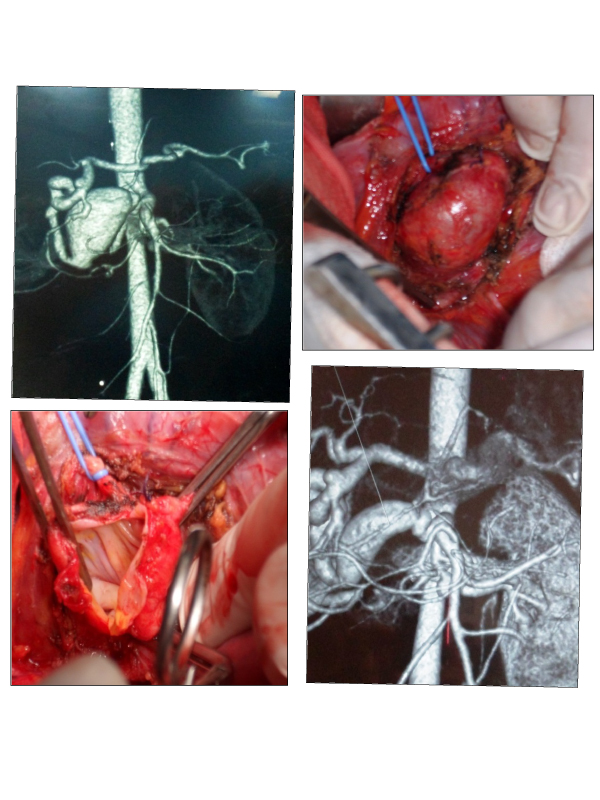2376-0249
Case Blog - International Journal of Clinical & Medical Images (2016) Volume 3, Issue 5

Author(s): Ben Jma� H�la, Elleuch Nizar, Jmal Hassen, Ghorbel Nesrine, Dammak Aiman, Frikha
Abstract: Arterial involvement in neurofibromatosis is infrequent. Stenotic lesions predominate. Aneurysms are less common. They typically involve the aorta, visceral arteries or carotid-vertebral circulation. They may present as a mass or spontaneous rupture. We present the case of a 26-year-old woman with a Von Recklinghausen disease, operated for a giant aneurysm of the duodenopancreatic arcade.
Keywords: Aneurysm; Von Recklinghausen disease; visceral arteries; aneurysmorraph
Introduction: Neurofibromatosis type I, or Von Recklinghausen disease was first described by Frederich Von Recklinghausen [1]. It is an autosomal dominantly inheritable disease [2]. It includes multiple skin café-au-lait macules, tumors of the nervous system, iris hamartomas, and skeletal deformities such as scoliosis [2,3]. Arterial involvement is rare but may have catastrophic complications. We report an unusual case of a non-complicated superior mesenteric artery aneurysm in a 26-year-old woman with neurofibromatosis type I treated surgically under a median laparotomy.
Case Presentation: R.E is a 26-year-old woman with neurofibromatosis type I (Recklinghausen’s disease) diagnosed since 5 years, and blood hypertension due to bilateral stenosis of the renal arteries, treated medically and by percutaneous angioplasty. She was admitted to surgery department complaining of abdominal pain and palpitations. The patient had no history of acute or remote trauma. Her physical examination was remarkable for the café-au-lait spotty pigmentation of the skin that is typical of patients with von Recklinghausen’s disease (Figure 1). The patient was hemodynamically stable, with a blood pressure of 144/94 mmHg and a pulse of 88 beats/min. A computed tomography scan revealed an occlusion of the celiac artery, and three non-complicated saccular aneurysms: an aneurysm arising from the duodeno-pancreatic arcade measuring 30 mm (Figure 2), an aneurysm of the splenic artery measuring 6 mm, and an aneurysm of pancreatic collateral of the superior mesenteric artery measuring 11 mm (Figure 3). The patient did not have any symptoms of bowel ischemia. So, a surgical repair under median laparotomy was decided.The largest aneurysm was dissected (Figure 4), was opened, and narrowed by an aneurysmorraphy (Figures 5 and 6). The patient made a full recovery and was discharged 4 days postoperatively. A follow-up CT scan (1 month after the procedure) showed patency of the artery without aneurysmal recurrence (Figure 7).
Discussion: Von Recklinghausen disease is an autosomal dominant disorder characterized clinically by café-au-lait macules, dermal and plexiform neurofibromas, skeletal abnormalities, optic gliomas, and iris hamartomas [2]. The prognosis of this disease depends essentially on the existence of cerebral tumors, which are responsible for death in 72% of cases [4].Vascular involvement has been described by Reubi [5]. It is rare with a reported prevalence of 0.4% to 6.4% [3]. It includes renovascular hypertension by stenosis of the renal artery, cerebral artery stenosis, aortic coarctation, occlusive, arteriovenous malformations and aneurysmal arterial disease [3].Arterial stenotic lesions have been more commonly described than aneurysms [6].The most frequently sites of aneurysms are the subclavian and vertebral vasculature where they can result in catastrophic hemorrhage [7]. Aneurysmal location of the visceral arteries is exceptional [8]. They involve mainly the splenic artery. Only a few cases of superior mesenteric artery aneurysm have been reported in this disease [9]. Fye, et al. [10] described multiple small aneurysms on the branches of the superior mesenteric artery. Huffman et al [8] reported a patient who underwent ligation of a ruptured superior mesenteric artery aneurysm. The vascular lesions described in our patient reflect the widespread vascular involvement with neurofibromatosis. They include three saccular aneurysms located in the visceral arteries, bilateral stenosis of the renal arteries, and occlusion of the celiac artery. The pathogenesis and natural history of these anomalies remains poorly understood [11]. Most patients have asymptomatic abnormalities of multiple vessels [12]. The clinical manifestations of aneurysm in cases of von Recklinghausen’s disease are characterized by compression, hypertension, and rupture [8]. Noninvasive imaging modalities such as duplex ultrasound scanning, CT scan and magnetic resonance angiography are useful diagnostic tools [9]. Visceral vasculopathy causes ischemic bowel disease; and catastrophic retroperitoneal or abdominal hemorrhage has been attributed to spontaneously rupture arterial aneurysms [13]. So, all aneurysms >1 to 1.5 cm in diameter should be treated [14]. The interventional approaches have proven their value, especially in vascular regions that are difficult to access. We decided not to do the endovascular treatment to our patient because operative treatment of large aneurysms is safe, effective, and durable.
Conclusion: Arterial vasculopathy is a well-recognized but uncommon manifestation of neurofibromatosis type 1. Occlusive or aneurysmal disease of arteries of all sizes may occur almost anywhere in the body, and their consequences can be extremely dangerous. So, a general screening of all patients with neurofibromatosis type I for arterial disease should be performed to prevent fatal outcomes of occult aneurysms [15].
 Awards Nomination
Awards Nomination

